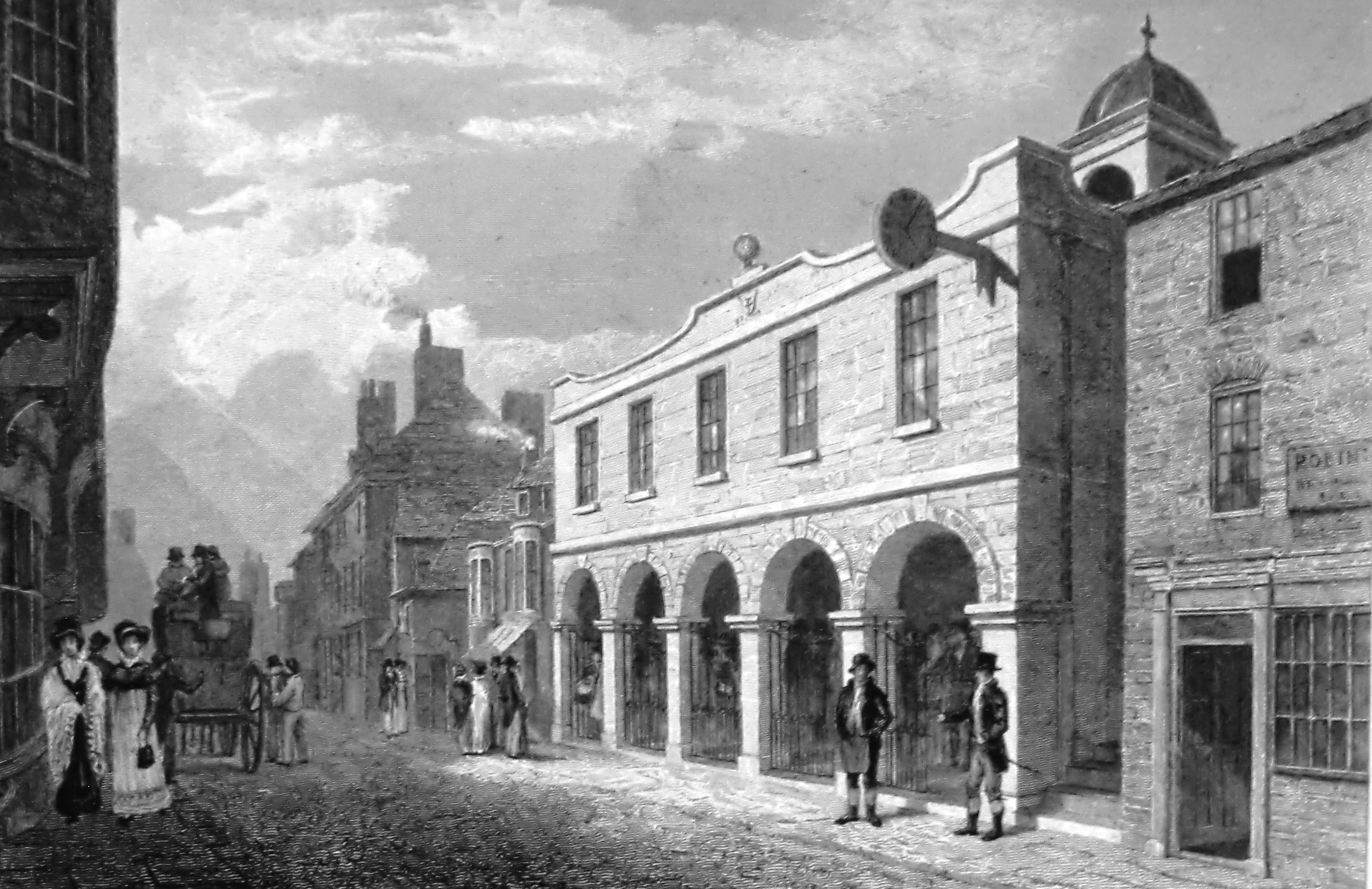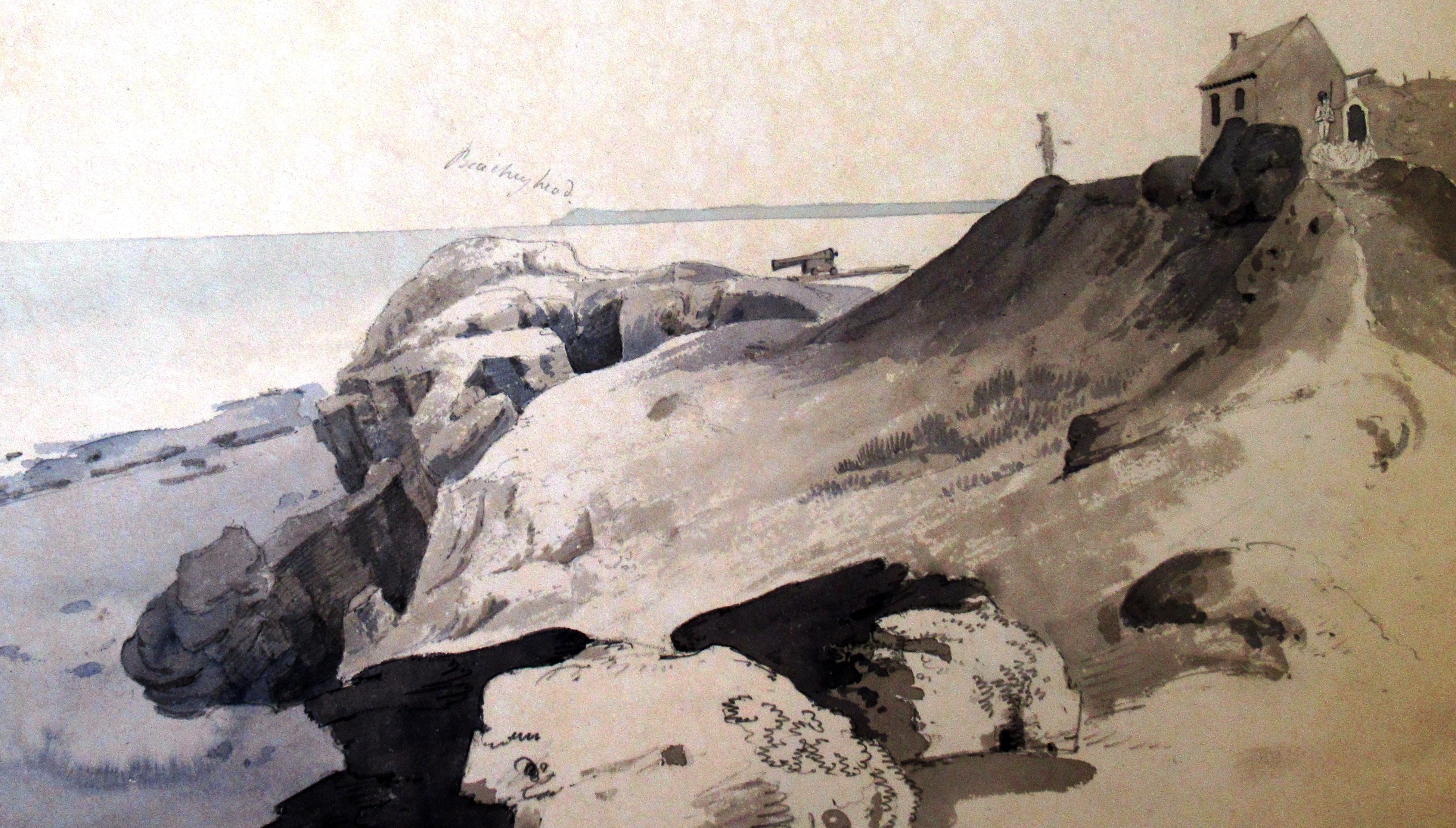1700-1799
1700 - A new town hall was built in the High Street, replacing the Court Hall that stood close to today’s junction of The Bourne and Courthouse Street, then the centre of the town. The Court Hall was a chamber above two shops, which disappeared long ago, and there were stocks and a whipping post nearby. The new town hall was paid for by the town's two MPs. The 1700 building was replaced on site in 1823 by the town hall that was the Old Town Hall Museum until recently. From 1700 to about 1816 the High Street was known as Market Street.
The town hall built in 1823 on the site of the one built in 1700.
1703 Nov 18 - A great storm, possibly the worst on record in Britain, caused widespread damage across southern England, although Hastings escaped serious harm. There were at least 600 houses, two churches, some public buildings and many shops (standing close to the beach) in the town at this time.
1706 June - An Eastbourne-born 20-year old solicitor, John Collier (1685-1760), was appointed town clerk of Hastings in what turned out to be a turning point in the history of the town. Collier and his two descendant relatives, Edward Milward Snr and Jnr, were to be the dominant individuals in the local establishment throughout the 18th century, becoming the rich owners of thousands of acres of land. Collier and the Milwards were mayors many times. They also ran the borough politically on behalf of the powerful Whig the Duke of Newcastle, who in return paid them and also appointed them successive managers of the Customs service in Kent, which brought them into close (and probably profitable) contact with the many smugglers along the coast.

John Collier (1685-1760).
1708-09 - A new school opened under the will of great local benefactor James Saunders, a large landowner in Kent who was born in Hastings. It was a free school for the poor, specifically for local boys and girls aged between six and 12.
1714-60 - The History of Parliament by R Sedgwick says: 'Under George 1 and George II Hastings was managed for the government by the Duke of Newcastle, who used the Treasury patronage to support his private interest as owner of the [Hastings] castle, lordship and rape of Hastings. From 1733 he employed as his local manager an influential member of the corporation, John Collier, who converted Hastings into a Treasury borough, where Newcastle nominated both MPs so long as he remained in office.' Collier was elected mayor for the first time on 4 May 1719, and again in 1722, 1730, 1737 and 1741. He was a canopy bearer at the coronation of George II. In 1731 he was the election agent in Hastings for the Duke of Newcastle.
1723 - Birth of Edward Milward Snr, who died 1811. He and his father (also Edward, 1682-1749) acquired a large amount of land in the Hastings area. He was mayor 26 times. He was a strong character who let nothing oppose him. In 1754 he married Mary Collier (1725-1783), a daughter of John Collier. His son Edward Milward Jnr continued having excessive power and influence over the running of the town.
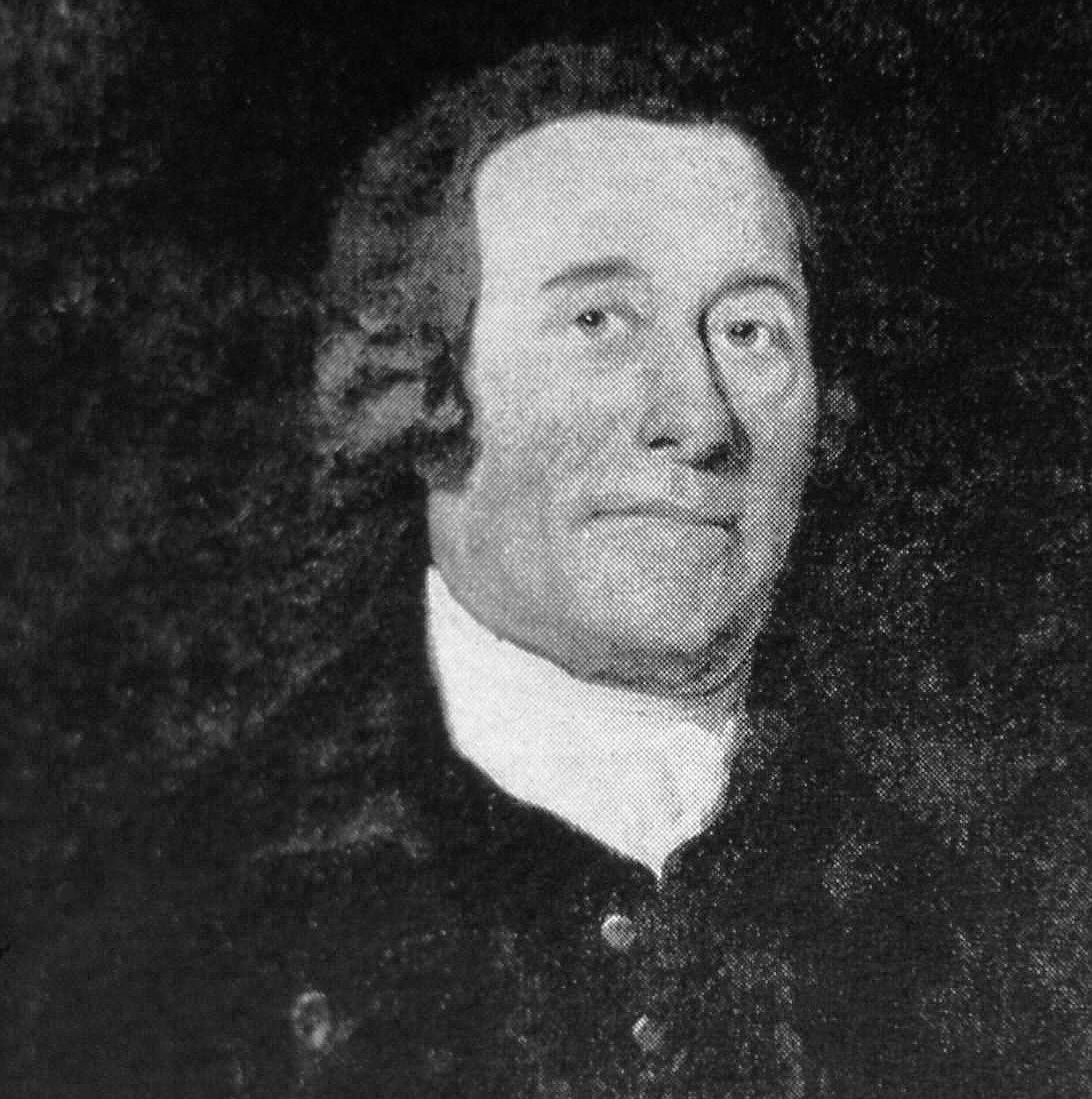
Edward Milward Snr (1723-1811).
1729 Late - There was an 18-month outbreak of smallpox, killing 91 of the town's 1,640 residents. About 705 were attacked. It was widely believed that the inoculation actually made the disease worse, including killing people. Pest houses were established and guards appointed.
1732 Nov - At a meeting of the town assembly and jurats called by John Collier, it was agreed to build a piped water system. This was because the town's main water supply was the Bourne stream, running between the High Street and All Saints Street, but this was also a heavily contaminated drain and sewer. A reservoir in the stream was dug in a field below where Dudley Road is now, and elm pipes with taps and stopcocks were laid down into the High Street. But only a few of the better-off households subscribed to it, and there was significant opposition from many of the people living in the town, claiming that the stream they relied on had become much less reliable and that they were having to pay for water that had been free until then. Although the system worked, it was not financially viable, and it probably went out of use in the early 1740s.
1733 - From this year the Customs onshore anti-smuggling forces of Kent were run by the leading establishment figure John Collier. In 1756 he passed on his anti-smuggling role - called Surveyor General of the Customs for Kent - and prominent position in the town to his son-in-law Edward Milward Snr. Local legend has it that Collier and Milward (who was mayor of Hastings 26 times) received large incomes from their liaison with the chief smugglers over several decades, as did other Customs officers around the coast. The senior officers were well-known for having little effect, because their positions were often filled by political jobbery; corruption, inefficiency and laxity were widespread
1735 Oct 24 - A large convoy of smugglers taking contraband inland from a beach near Hastings was ambushed by Customs officers and soldiers at Hollington. There were about 30 laden horses and 'a great many men'. On being challenged, all the smugglers escaped, bar one, who was shot dead. The smugglers were the Hawkhurst gang, and over the following years the gang became increasing violent, but lost its support from neighbouring areas. This helped the Customs launch a major campaign against the gang following their brutal murder of two people after their raid on a Customs House in Poole, Dorset, on 8 October 1747. In the following months the gang was broken up, with several members being executed, and others dying in prison.
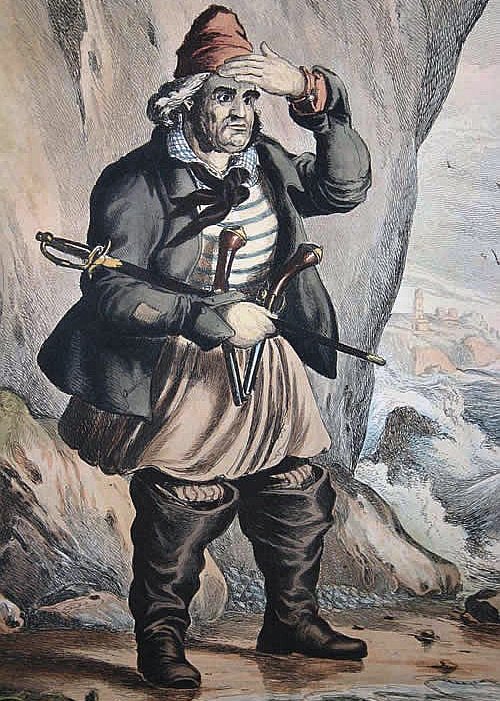
A smuggler keeping an eye open for Collier and Milward.
c1736 - The borough’s Book of Records of the time of Edward IV (1461-1483) was 'lost'. In fact, it was probably destroyed by the local establishment to get rid of serious legal question marks it raised over their inherited privileges, especially land ownership.
1739 - John Collier, who owned the Old Hastings House at the top of the High Street, built new stables across the road, which in 1959 became the Stables Theatre. The house, which had extensive gardens, was built around 1700 and was initially called The Mansion, being renamed as Old Hastings House in 1892. When Collier died in 1760 the house was passed down through the Milward family. From 1873-91 it was rented by the Victorian poet Caventry Patmore, who helped build nearby the Catholic church St Mary-Star-of-the-Sea. The house was used as a military hospital in the First World War. In 1947 the Hastings Old People's Welfare Committee opened it as a home for elderly residents, and it was purchased by the Magdalen and Lasher Charity in 1981.
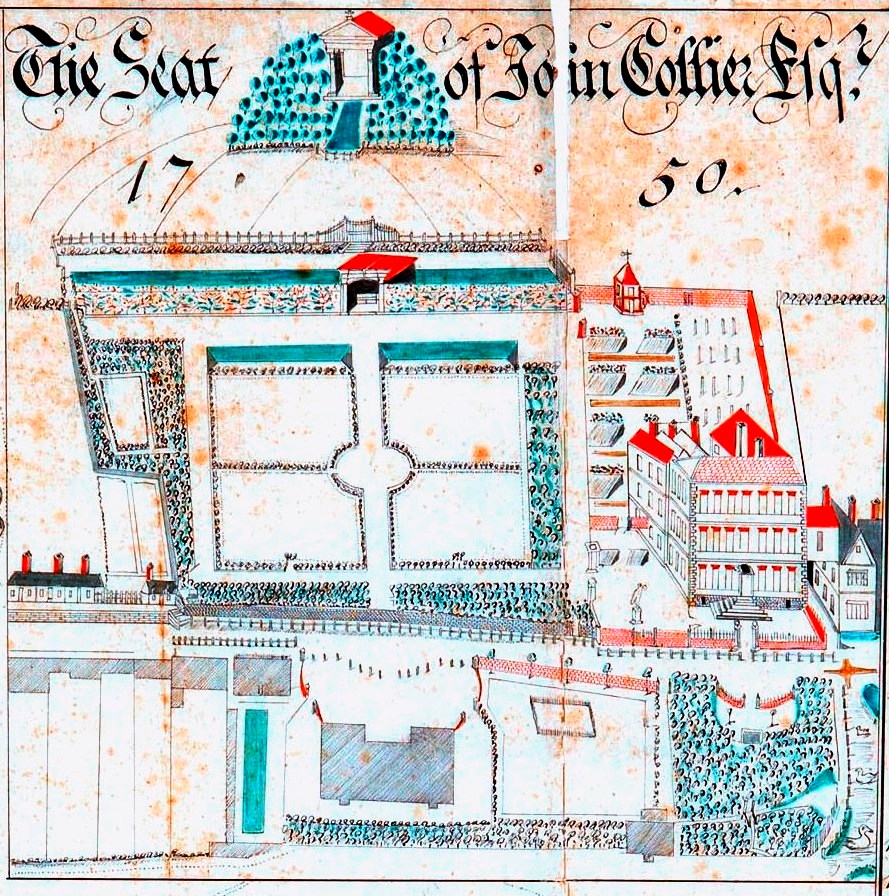
Old Hastings House (on the right) and its garden. The stables are the big building opposite.
1744 - The first street lighting system began, following the donation by local wealthy MP Colonel Pelham of some oil lamps. The system was limited and expensive, and only ran for about ten or 11 years.
1745 - Launch of the Lewes-based Sussex Weekly Advertiser, the first newspaper to cover Hastings, and also the first newspaper to be published in Sussex.
1745 - The proprietors of the coach called Regulator said 'this fast coach' left the Swan Inn, Hastings, at 4am on Mondays, stopping overnight at Robertsbridge and then Sevenoaks, reaching London on Wednesdays, returning to Hastings on the following three days. By the 1790s road improvements had made it possible to reach London in one day.
1746 - The Bourne Stream was covered over and paved from Courthouse Street northwards as far as All Saints Church, forming Bourne Street. Today's road through the Old Town, the Bourne, lies on top of some of Bourne Street.
1746 - A map was drawn by local surveyor and schoolmaster Samuel Cant for Hastings Corporation, showing the town’s boundaries. This was the town's first large-scale map, but it only showed the areas close to the boundaries.
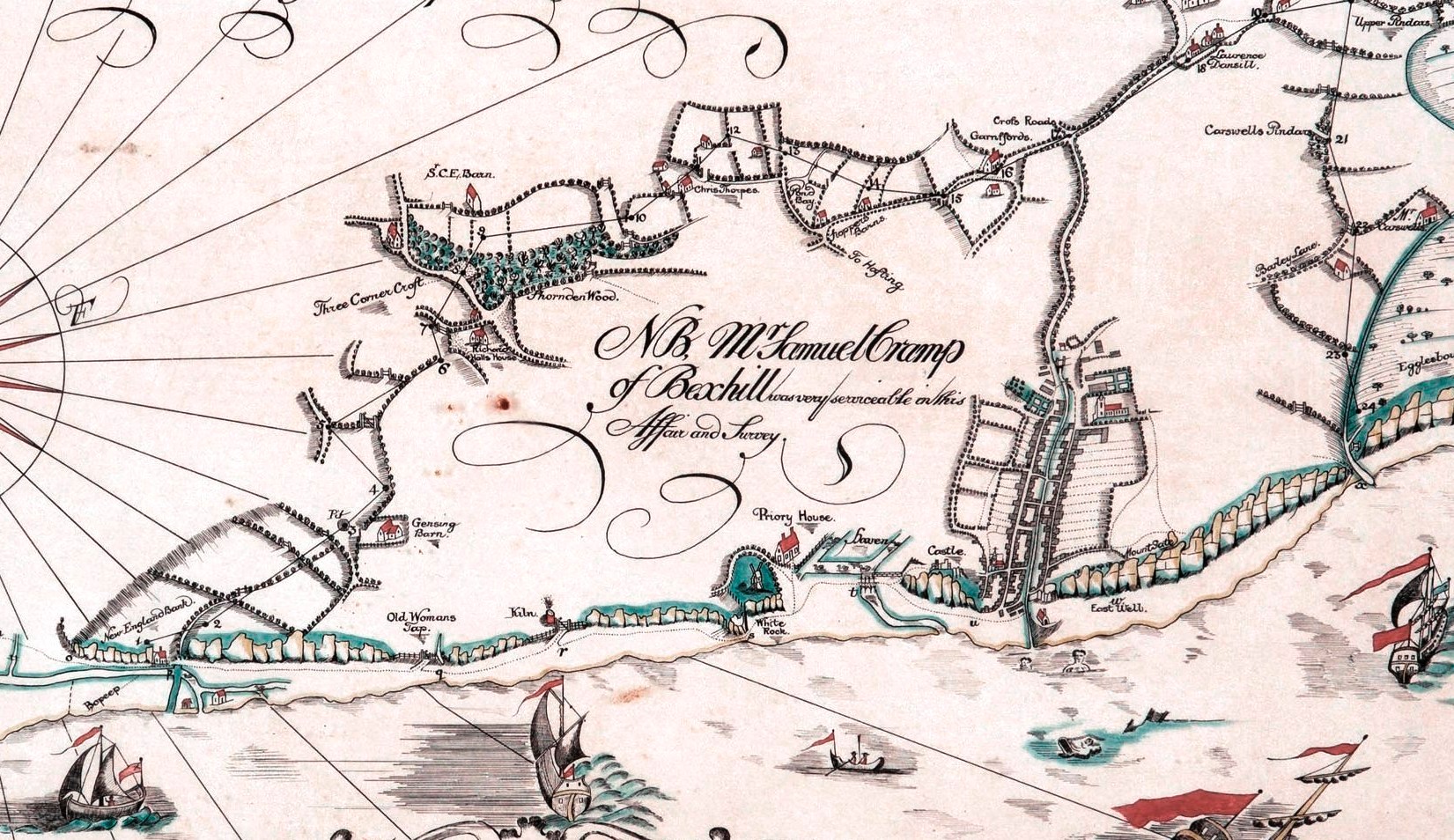
Part of Samuel Cant's 1746 map of the town's boundaries.
1749 Jan 26 - The heavily-armed Dutch merchant ship Amsterdam was run ashore at Bulverhythe in a gale. The big East Indiaman was on her maiden voyage from Amsterdam to Java, and had sailed with over 330 people on board and carrying two tons of silver. But as she entered the English Channel her rudder was torn off in a gale, and at the same time many members of the crew were dying of a disease. The surviving crew forced the ship to drive onto the beach at Bulverhythe in order to escape the threat of death by the disease. Two-thirds of the three-masted ship, now owned by the Dutch government, still lie in the sands opposite the railway sheds, and can be seen at very low water.
1749 - The town’s first fire-fighting service was set up. One or more fire engines were donated by the town’s two MPs. They consisted of a pump on wheels, with a long wooden hand-rail on either side which was worked up and down by relays of men, They were stored under the town hall in the High Street.
1750 - The earliest-known large-scale map of most of Hastings was made by Samuel Cant. The map had been commissioned by the town’s most powerful man, John Collier, to show the land that he owned on the East and West Hills, in the Bourne and Priory Valleys and in lower Clive Vale. The map shows the town was concentrated at the seaward end of the Bourne Valley, plus the full lengths of High Street, All Saints Street and George Street. There were two ‘gun gardens’: where today are Sturdee Place and the bottom easterly corner of All Saints Street. Windmills were on the West Hill, near where the Plough Inn is today, and on top of White Rock. The top of the East Hill and much of the rest of the land was fields. The map included a picture of Collier’s residence, today called Old Hastings House, at the top of the High Street, showing a large building, with a well-laid-out garden and stables (today’s Stables Theatre).
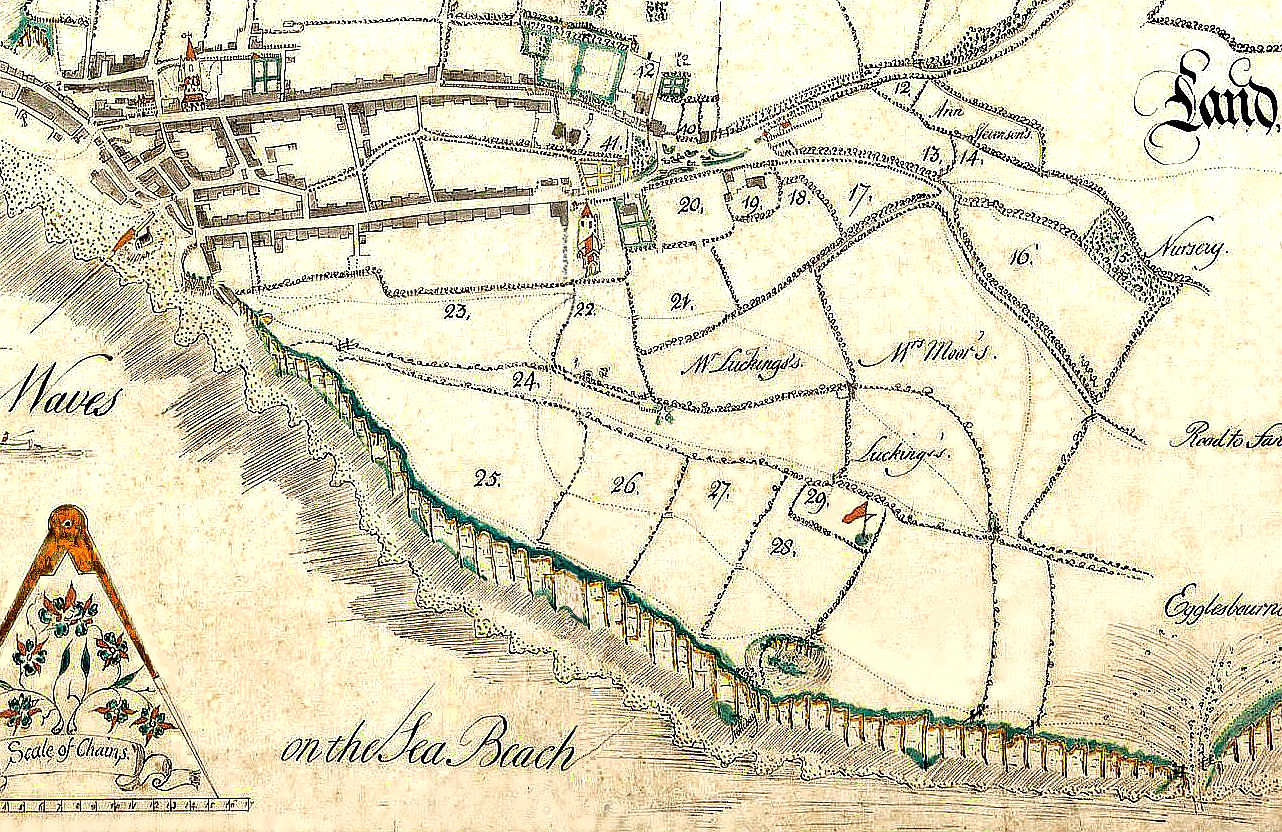
The East Hill and Old Town on Cant's 1750 map of the Collier estate.
1753 - The Hastings-Flimwell Turnpike Act 1753 allowed the creation of the first turnpike road in the Hastings area. The act was acquired by prominent local landowners - including John Collier and Edward Milward - and it let them take control of the existing Hastings-London trackway, from the top of the High Street, via Old London Road (then called Hastings Hill), Ore, Battle, Whatlington, and Robertsbridge to Flimwell. Once the trustees had improved the road they could charge people using it by erecting tollgates, where a toll could be levied on all road users. Work started at the Hastings end, with the first tollgate being put up in June 1753 at Mount Road. The road improvements took three years to complete, with nine more gates being installed through to Flimwell. By the early 1760s the greatly improved road connection with London enabled Hastings to become much more popular with visitors. In 1814-15 the trustees spent a large sum on improving Hastings Hill, then one of the most difficult parts of the whole turnpike. Nearly a mile of the Ridge at Beauport was re-laid as a new road in 1824-25. The Hastings-Flimwell trust was wound up in 1880.
1753 May 22 - At a meeting of the three local parishes - All Saints, St Clements and St Mary-in-the-Castle - it was agreed that the three would combine to build a ‘public workhouse’. This would be on the site of a building at the west end of George Street called Pilchard Houses, which had been donated by the prominent local MP Colonel Pelham, who owned much land in the Hastings area. Several local notables - including the then-mayor Edward Milward, John Collier and Sir Charles Eversfield - loaned £500 to the parishes to help build the new ‘Workhouse for the Poor’ (also called the ‘Poor House’), and Col Pelham and Andrew Stone donated £400. The building, on the site of today’s No 42, opened on March 20 1754.
1756-63 - The Seven Years War was a global conflict involving many nations, with a struggle between Britain and France at the heart of it. It ended with a truce in 1763, but Britain emerged as the most successful fighter, thereby establishing it as probably the most powerful naval force in the world. In this, as in later protracted conflicts with France, letters of marque were granted to the adventurous seamen of both nations, and at Hastings privateering vessels were built - some to order and some in speculation. In March 1759 two privateering cutters were sold at the Swan Inn: the 70-ton Fox (8 guns, for crew of 40), and the Lion (10 guns, for a crew of 60).
1759 March 28 - Two Hastings men, Nicholas Wingfield and Adam Hyde, masters of two privateer cutters, were hanged for piratically boarding a Danish ship.
1760 - Because of fears of French attacks on England, the Board of Ordnance in October 1759 approved a programme of fortification in Sussex and Kent. Nine 'sea-batteries' of cannons were built between Folkestone and Arundel Haven, including one at Hastings on the beach at the west end of West Street, completed in 1760. The battery had eleven 12-pounder cannons. It replaced the two batteries built on the seafront in the early 1690s (cf). By 1762 the Crown had taken ownership of the battery site, and of a piece of ground at the bottom of the cliff slightly to the west, where a military base with gunpowder storage was built. This site later became a large Coastguard station, and stayed in Crown ownership until the early 20th century. The last Coastguard building (built 1904) is still there, as the shops with flats above called Sturdee Place. Being on the site of the harbours built in the 1590s, the 1760 battery also provided shelter for fishing boats using the beach to the east. A small Customs house was erected on piles at the east end of it, nearly opposite the Cutter pub. In 1805 a Customs boat house (29 ft by 10.5 ft) was built next to the house. The house was destroyed by the sea and a larger replacement house was built a few yards to the east in 1818. The battery was dismantled in 1817 and the site cleared in 1842.

The 1760 battery of cannons (with the flag flying).
1760 May 27 - In one of the first indications that Hastings was becoming a seaside resort, a notice in the London Chronicle said: 'The inhabitants of this town [Hastings] beg leave to acquaint the public that a handsome and convenient machine for Private Bathing in the sea is now finished and fit for immediate use, that a variety of lodgings, with decent furniture, are in readiness and to be let on reasonable terms.' This notice followed a feature the Chronicle published in late February praising the town. Hastings had been attracting a slowly increasing number of visitors since the 1740s, thanks very much to the positive exertions of John Collier. The increasing popularity of the town had inspired the creation of the 1753 turnpike road, which itself helped the town become an expanding semi-fashionable resort by the 1790s.
1760 Nov 1 - Very high tides and a gale produced widespread flooding. As a result of this and similar floods the roadway in George Street was heightened, thus placing many of the houses and shops, especially on the south side, below the ground level of the street.
1760 Dec 9 - Death of John Collier, aged 75, the most powerful establishment figure in Hastings from c1710 onwards. He had acquired a very large amount of land, including much of what is today the Country Park. He had 24 children, but only five daughters survived him, one of whom, Mary, married Edward Milward Snr. Milward acquired most (if not all) Collier’s property, and by the end of the 18th century he owned most of the undeveloped land between the Priory Stream and Fairlight Church. Collier’s widow Mary wrote in 1764: 'The way he [Milward] goes on here is quite amazing to all the world; neither house nor land within ten miles of this place that he will not purchase if it’s possible, by offering more than people can withstand.' Another daughter of John Collier, Cordelia, married Major-General Sir James Murray, Governor of Quebec Province 1763-6 and the builder of Beauport house on the Ridge in those years.
1762 - East Cliff House was built at the bottom of All Saints Street by Edward Capell, the government's deputy-inspector of plays and a great advocate of Shakespeare's work. It is an early example of a sea-facing villa, from the earliest days of Hastings starting to become a seaside resort. It was built on the site of the 1690s eastern fort, then just made redundant following the construction in 1760 of the big battery to the west.

East Cliff House (on the left), in 1784.
1768 - A group of gentlemen planned to make Hastings a ‘Bathing Place’, and they considered buying the Old Hastings House stables (today the Stables Theatre) to convert into a social centre at the heart of the new resort. But the scheme came to nothing. A document of 1768 mentions 'the tammares trees at the East Well', referring to the tamarisk trees which one grew profusely on the East Hill cliffs.
1768 May 18 - There was a riot when a large mob gathered in Hastings to protest at the high price of bread. The organiser was arrested and sent to Horsham for the assizes, but he was rescued by the protesters, and they only calmed down when wheat was made available to them at a fair price.
1768 Aug 15 - The Ruxley crew, a large gang of mainly Hastings men who had been carrying out piracy for seven years, ransacked two Dutch vessels off Beachy Head. Folklore has it that the master of one of the vessels was axed down the back, giving Hastings seafarers the name of ‘Chopbacks’. and that in November 1768 a brigade of 200 dragoons were sent to Hastings to arrest the crew. But it is not certain that the axing and the deploying of 200 dragoons actually took place. However, at the Old Bailey in October 1769 fourteen men were convicted, probably for political expediency, and four were executed on 27 November.
c1770 - The parishes of All Saints and St Clements were united in one rectory.
1771 April 5 - The town’s main hotel, the Swan, was taken over by Thomas Havenden, late of Rye’s George Inn. He carried out major improvements, and in August 1772 its new Assembly Room opened with regular dancing, card-playing and music, reflecting the town’s rapidly increasing popularity as a seaside resort. In 1779 the Swan was taken over by local businessman William Scrivens. It was demolished in 1889.

The Swan Hotel in the 1880s.
1773 April 6 - The three local parishes agreed to end their joint workhouse agreement and go back to separate workhouses for each parish. St Clements carried on using the joint building in George Street until 1776, when for three years it was at the silk factory where 1 Croft Road is today, and then back to George Street. The new Union workhouse in Frederick Road opened in 1837, when the George Street workhouse was demolished and replaced by today’s No 42 George Street. All Saints parish mainly used 125-6 All Saints Street until c1820. The St Mary-in-the-Castle workhouse was initially at the Harrow and then in Wellington Place where McDonalds is today.
1778 - Regiments of troops were encamped on Fairlight Down. In September 1779 they struck their tents and moved inland to Westfield, less exposed to bad weather.
1778-83 - Surveyors Yeakell and Gardner produced the first detailed map of all Sussex. The two inches-to-the-mile map shows Hastings as still being largely confined to the Bourne Valley.
1780 and 1784 - Serious outbreaks of smallpox caused many deaths. A small house almost on the beach at the bottom of Fairlight Glen was used as a ‘Pest House’, from which non-infected people were banned.
1783 June 9 - The Sussex Weekly Advertiser carried an advert for a 'new and elegant light Post Coach' service with London, four days a week, taking about 12 hours.
1784 Dec 30 - Hastings fisherman George Wood was shot dead by three soldiers of the Light Dragoons while trying to escape on his boat from Revenue officers. Wood put to sea in his boat to avoid it being searched and was shot. There was great consternation, and the three soldiers were locked up in the town gaol, outside which fishermen kept a 24-hour vigil to prevent their relase. A military party of armed men took the three troops away, despite protests. Private Joseph Bevan was found guilty of murder at Lewes assizes in late March 1785, but then pardoned and freed.
1785 Sept 7 - There was a severe storm, and fishing boats were hauled up the High Street as far as the Swan Hotel.
1786 - The Lovers Seat lovers - Elizabeth Boys (daughter of the High Sheriff of Sussex) and Capt Charles Lamb of Rye - were married. Capt Lamb was the commander of an anti-smuggling Revenue cutter, the Stag, who courted Ms Boys, of Hawkhurst, despite the opposition of her father. She was staying at Fairlight Place, so the pair could only meet in secret at Lovers Seat when the captain’s vessel was off that part of the coast. After marrying, the couple lived happily for 28 years until the captain died at sea. There have been many romanticised versions of this story, not least because Lovers Seat was a most unusual and attractive spot for lovers of all kinds to meet.
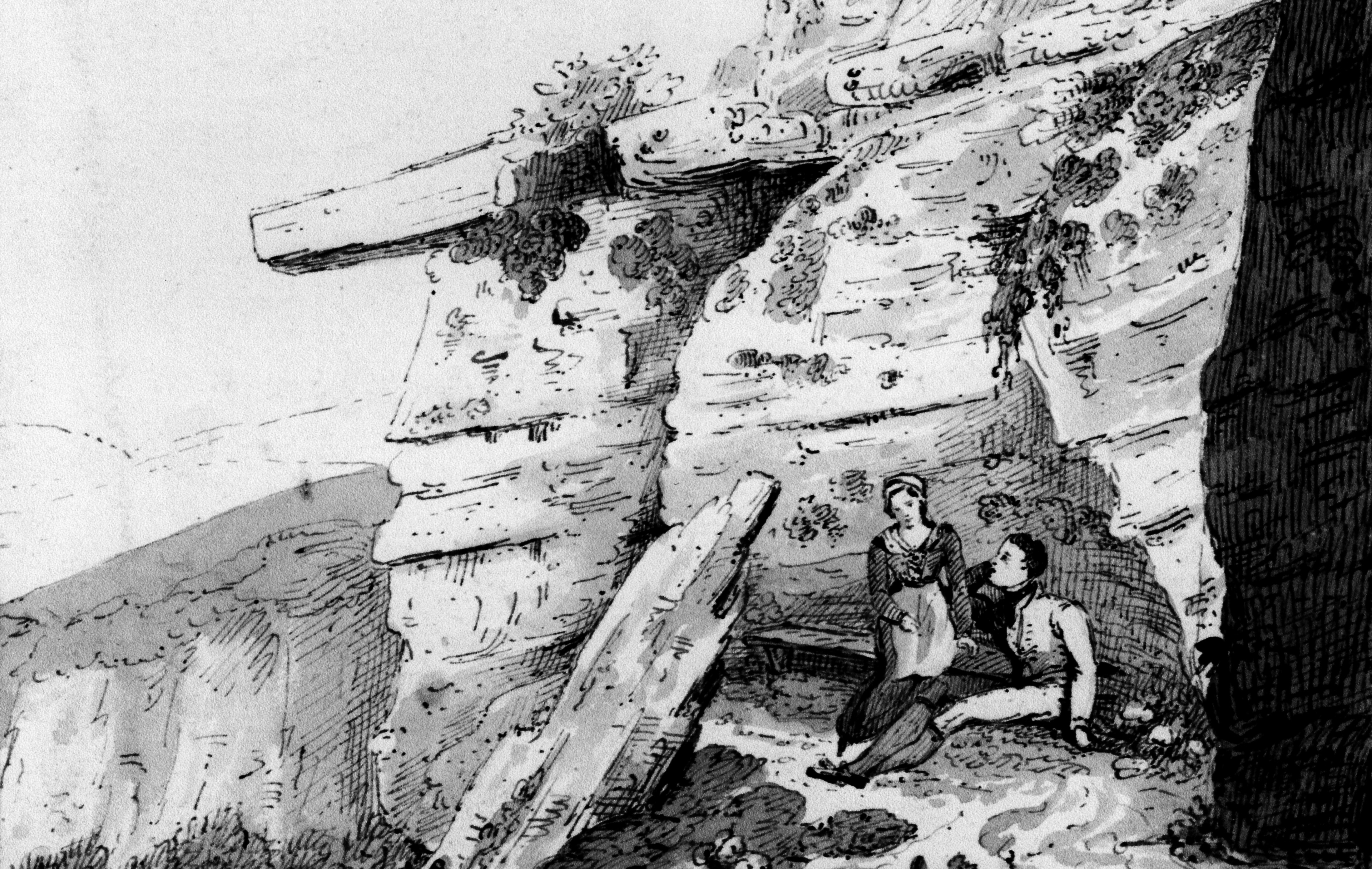
Lovers Seat - and the two lovers?
1786 Aug - The Gentleman's Magazine said: 'This town [Hastings], from its pleasing situation near the sea, its bathing machines, the many pleasant walks and rides about it, diversified with the most agreeable prospects, has become, in proper season, the resort of a numerous and genteel company.' The magazine also had a picture of a cave on the slopes of the West Hill being lived in by an old couple who had been thrown out of the workhouse for 'repeated misbehaviour'.
1787 Sept-Oct - General William Roy set up a 32-feet high scaffold and theodolite where North’s Seat is today, or close to it. He was making observations of the coast of France as part of the triangulation survey linking London and Paris that resulted in 1791 of the setting up of the Ordnance Survey, the world’s first official surveying body. Fairlight and Dover were the two key English cross-Channel observation points. The 1787 survey enabled the production of the first one-inch-to-the-mile maps that began in the 1790s.
1788 May - The first Hastings ‘circulating library’, run by John Stell, opened where 1 Croft Road is today, opposite St Clements Church, to meet the growing needs of visitors. From about 1776 (or possibly earlier) Stell had run a silk factory in the original building on that site, which was also the St Clements parish workhouse from 1776-79. It stretched at least 100 feet up Cobourg Place, with 20 looms and a warping mill on the ground floor, and a winding engine running 75 swifts and bobbins on the upper floor. Stell and several London backers invested £10,000 in the venture. But the silk factory failed, so in 1788 they turned it into a library, with Stell saying it was based 'on the plan of those at Margate and other watering places, there being nothing of the kind ever before attempted at Hastings'. It had a billiard table, newspapers, magazines and about 1,500 books. It became a social centre for visitors but it was too far from the sea - 'an injudicious location', Stell later recalled. In 1794 he published the first-ever Hastings Guide from his library. But in 1795 he gave up, and sold the library contents to James Barry, who had started the Marine Library in 1791 on Marine Parade at the west end of George Street, which had obtained most of the custom. Barry also took over the Guide, publishing the next edition in 1797. In his 1815 edition of the Guide Barry said his library had 'recently been considerably improved'. The Marine Library has been replaced by a fish and chip shop.
1789 - The start of the Napoleonic War brought an increased military presence in the Hastings area.
1789 - The rapidily-developing town of Hastings needed better management, so the Hastings Improvement Act 1789 gave a new commission power 'for paving, cleansing, lighting, improving and regulating the streets, lanes and other public passages and places, and for repairing the highways, within the parish of St Clement' - but not in All Saints parish. The Act appointed 43 local 'commissioners', the first named being Edward Milward Snr, all of whom had to either (1) receive at least £10 pa in rent from land or buildings, or (2) be a tenant of land or buildings paying at least £20pa, or (3) be owner of an estate worth at least £300. This Act was replaced by the more comprehensive 1820 Improvement Act (cf) which embraced the two other parishes of All Saints and St Mary in the Castle.
1789 Jan - There was widespread poverty. Edward Milward ordered four oxen to be slaughtered and distributed, with bread, to the needy.
1790 - About this time, Dr Matthew Baillie, a physician to King George III, first recommended patients coming to Hastings.
c1791 - The construction of the first promenade, Marine Parade, began. It was completed as a far west as Pelham Place in 1812.
James Barry's library, on the left.
1791 - James Barry started the Marine Library and billiard room at the west end of Marine Parade and George Street, where the roads met. It was a rival to John Stell’s 1788 library in Croft Road (cf). Between 1800 and 1804 Barry also opened the town's first warm baths, on the seafront near his library, adjacent to the Lower Lighthouse. Barry came from an old Hastings family, two forefathers having been in the 1588 contingent against the Spanish Armada. He managed the library until he died in 1822, aged 63.
1791 May - Start of the first bank in Hastings, the Hastings Old Bank, at 90 High Street. It was formed by Messrs Tilden, Shadwell, Hilder, Harvey and Gill. Other banks were started in the early 19th century, but throughout its life of over 60 years the Old Bank remained the main one in the town. In 1842 it moved to the seafront at 9 Pelham Place. Then suddenly on 26 June 1857 it shut its doors and suspended payments. It had advanced over £150,000 to a Salehurst farmer, Richard Smith, who was related to two of the then partners. Many people were owed large sums, but it is believed that eventually all debts were paid.
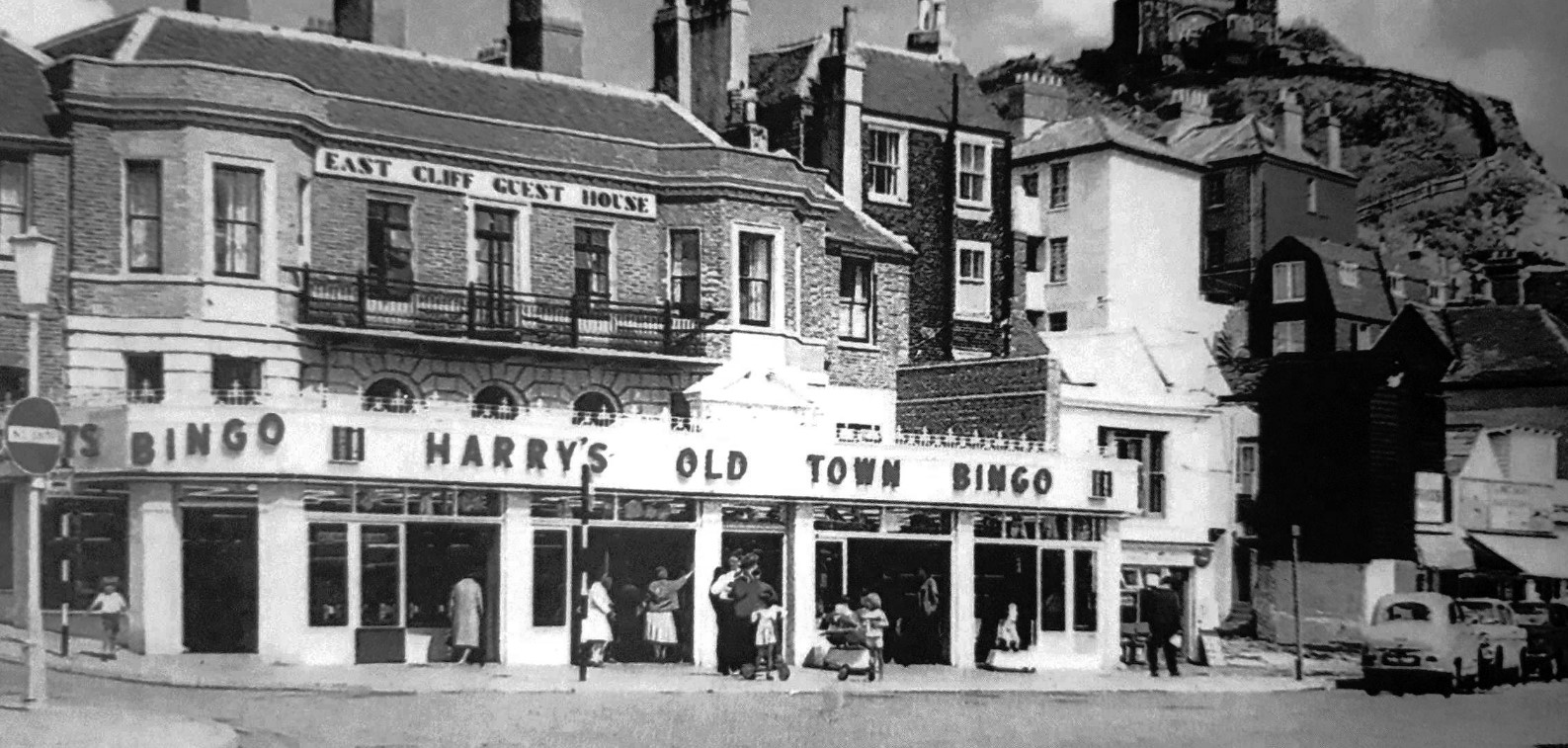
1792 - Thomas Oldfield wrote in his book History of the Borough that many of the records of the Cinque Ports had 'of late years been purposely destroyed or put out of the way; as they would otherwise have clearly shown (if suffered to be brought into day) that, in almost all of them [including Hastings], their present government is a direct violation of, and a gross and scandalous usurpation upon, their original and real constitutions; that the greater part of the inhabitants are defrauded and cheated out of their just rights; and that the privileges of the many are bartered away, to enable a corrupt and profligate junta, in each place, to prey upon the vitals of the public, and to fatten on its spoil.' Oldfield believed that John Collier and then the two Edward Milwards controlled the Hastings ‘junta’, from which they made large sums of money. Hastings has few official records dating from before the 18th century, as they were destroyed by the ‘junta’ at some point.
1792 - The name ‘East Hill’ first appeared in deeds. Prior to that, from at least 1540, it was called St George’s Lands (later St George’s Hills).
1792 Jan 26 - There was the worst combined storm and high tide since 1703. It was the highest tide in living memory, combined with furious southerly winds. The George Street area was flooded, net shops and capstans were washed away and there was damage along the coast.
1792 Sept - French ecclesiastics fleeing from France landed at Hastings.
1793-1815 - During the Napoleonic Wars, Hastings was in the front line because it was so close to France. In fear of a French invasion, troops were stationed in the town in encampments and specially-built military barracks around the town. In 1795 Edward Milward sold to the government about 30 acres of ground at Halton, where temporary barracks were built in 1798, and then replaced by the town's main barracks in 1803-4. These were sold off to Boykett Breeds in 1823, making way for development. The 1794 barracks at Bopeep, holding about 200 soldiers, were accidently burnt down in February 1804, and then rebuilt. There were also barracks at Bexhill, Battle, Winchelsea and probably Pett, plus encampments on Fairlight Down. Milward’s High Street stables (now the Stables Theatre) were converted to barracks in early 1797. Troops were also billeted around the town, and there was a marked increase in the number of illegitimate children, as also happened in Hastings in World War Two. In 1797 a cave in the cliff under the castle, where Castledown Terrace is today, was enlarged and used as a hospital. A volunteer force, the Sea Fencibles, was formed in February 1798 to man the batteries and defend the town.
1794 - The town's first guide book was published in July. The Hastings Guide was published by John Stell, who had opened a library in 1788 (cf) in Croft Road. The Guide said it was compiled by an 'Inhabitant'; this was probably Stell's father-in-law,the Rev W Coppard, and teacher John Shorter, who was married to another of Coppard's daughters. Stell's business-rival James Barry, who had opened the Marine Library and billiard room on Marine Parade in 1791, bought out Stell and the Guide's copyright, and published a new and bigger edition in his own name in 1797. The third edition was published in 1804, reporting the 1801 census as saying that the population of Hastings was 2,982. The final edition was the seventh, published 1828. Barry was said to be a man of 'indomitable energy and public spirit'.
1794 - The new Hastings Guide described the town in detail. Large sailing vessels (50-100 tons) were wound up the beach by a capstan with three or four horses, and launched by being pushed down the beach by a 'large wooden screw' applied to her bow, over greased wooden blocks. 'Fifty or sixty years ago' the trade of the town was very considerable and the fishery was much more considerable, especially in herring. A great deal of planks and grain were brought to Hastings for export along the coast. The main import by sea was coal, especially since the town had become a seaside resort for the well-off. Many boats were built at Hastings, 'for which the boat builders are esteemed famous'. Markets were held on Wednesdays and Saturdays, and there were three fairs annually: Whitsun Tuesday, the Rock fair on 26-27 July and 23 November. Stage coaches ran to and from London on three days every week (four in summer), taking 12 hours or more. Two large waggons carried heavy goods between Hastings and London, taking at least two days each way, and three sloops brought items by sea. There were 12 or 14 bathing machines on the seafront. There was a 'very good assembly room' in the Swan Inn, plus there were two libraries and numerous lodging houses, several built recently. West of the town was the Bo-Peep pub, serving 'tea and good cream'.
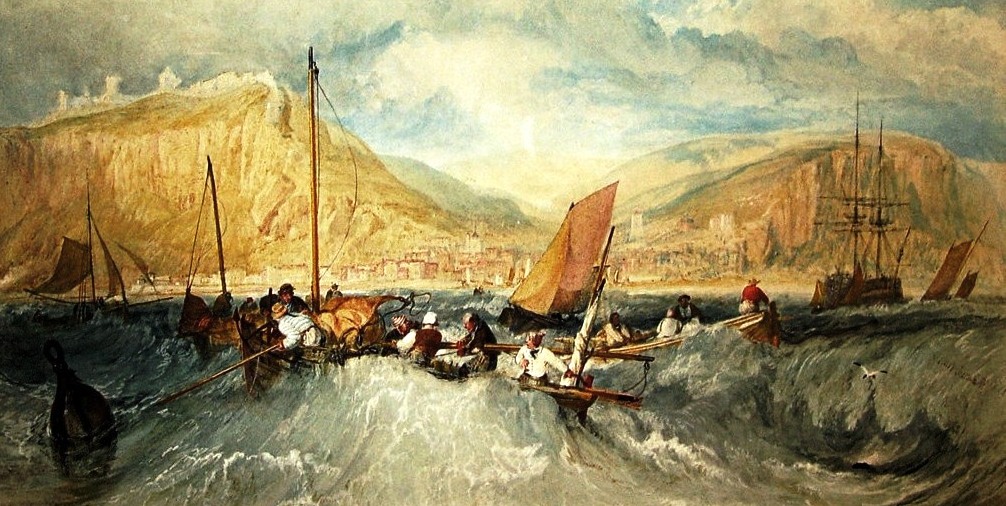
Off Hastings, by the famous artist JMW Turner.
1794 - The Crown Inn was built on the corner of All Saints Street and Crown Lane, as a rival to the Swan Hotel in the High Street. It burnt down and was replaced by the existing Crown pub in 1921.
1794 April 17 - An anti-French volunteer corps of infantry was formed at a meeting in the town hall. The corps, with 70 or so members, was funded by donations from local dignitary. The battery at the west end of the seafront was improved
1794 June 18 - Death of General Sir James Murray, aged 75, at Beauport. He was a hero of the 1759 English siege of Quebec. He had had Beauport built, and named it after part of the city of Quebec. His first wife was a daughter of John Collier.
1794 Sept 22 - The officers of the large military encampment on Fairlight Down gave a ball and supper at the Swan Hotel, to which all ranks were invited. Another took place on 13 October for all the principal gentry within a ten-mile radius of the town (200 people took part).
1794-95 - A ‘Signal Station’ was built where Fairlight Coastguard radar is today. This was one of a line of such stations set up by the government in late 1794 and early 1795 along the south coast, to monitor shipping movements, identify enemy vessels and communicate with defence forces by day and night. Each station consisted of a small wooden hut-cum-cottage, prefabricated in Portsmouth Dockyard, and an 80 feet high mast able to fly flags and display signal balls. All this was delivered by sea to the nearest landing site. Fairlight’s nearest neighbour to the east was at Dungeness point, and Galley Hill to the west. In 1818 or 1819 the building was probably demolished and replaced by a bigger Coast Blockade Service watch house and semaphore station, later becoming the site of Fairlight Coastguard station.
1795 - Nos 1-5 Marina were built.
1796 - A French privateer captured a British vessel off Hastings; it was re-taken a few hours later by local fishermen and military volunteers. There was much activity by French and British privateers in the late 1790s.
1796 - There was widespread unrest because of the high price of wheat and bread. One of Edward Milward's wheat ricks was burnt down. On 11 June 1796 there was a bread riot involving women and boys, breaking windows of a miller, Mr Edwards.
1796 Dec - There was a serious outbreak of smallpox, with many deaths.
1797-1806 - Three surveys were carried out in the Hastings area by the newly-formed Ordnance Survey as they prepared their first series of maps, the one inch-to-the-mile published from 1813. The surveyors’ drawings are viewable on the British Library’s website.
1797 - The opening pages of the 1797 edition of the Hastings Guide said: 'One circumstance must, above all others, render Hastings dear to those who have a regard to morality; Vice has not yet erected her standard here - the numerous tribe of professional gamblers, unhappy profligates and fashionable swindlers find employment and rapine elsewhere. Innocent recreational delight, card assemblies, billiards, riding, walking, reading, fishing and other modes of pastime banish care from the mind, whilst the salubrity of the atmosphere impels disease from the body. The society of Hastings are gay without profligacy, and enjoy life, without mingling in its debaucheries.'
1797 - The Admiralty built a battery of three guns on the headland of White Rock. The guns were taken from the Spanish warship San Josef after Nelson's victory at the battle of Cape St Vincent in February 1797.
One of the cannon on White Rock.
1798 - Local historian Thomas Brett recorded: 'One of the perpetual causes of contention was that some part of the stade and all the waste beach outside of the town westward to the Priory Bridge' [today that is from the west end of George Street to Harold Place] 'that was claimed by the Corporation did not belong to them. The contestants were chiefly those inhabitants who were connected with the fishery.' So the Hundred Court set up a committee to manage the waste beach, acting as though the Corporation [Hastings Council] did own it, but at the same time seeking counsel's opinion on the matter.
1798 May - Forty special constables were sworn in at the Hundred Court in fear of civil disturbances. They were mainly tradesmen, plus some other well-off men. All public entertainment had been banned two months before then.
1799 - A smock-type windmill was built on the southern corner of Priory Road and Croft Road. Its owner was Hastings baker John French, who worked it until his death in 1820. In 1838 much of it was moved to Silverhill, although the bottom of it is part of the house now standing on its site.
1799 - One of the first Freemason lodges in Hastings was set up, the Harmony. It was established by members of the Royal Westminster Regiment, then stationed in the town. In 1817 the Harmony Lodge merged with the Derwent Lodge, which may have originated in a lodge formed in the Cutter Inn in 1755. Many other lodges were set up in the Hastings area in the 19th and 20th centuries. The Freemasons have played a key background role in the running of the town, with many well-known individuals being members. The many lodges are today based in the lower ground floor of the Masonic Hall, behind the Royal Victoria Hotel.
1799 Jan 20 - Elizabeth Lavender, an unmarried and impoverished woman, gave birth to a boy at Fairlight and immediately killed him with a knife. On 19 July 1799, she was found guilty of murder at Lewes Assizes and was hung three days later.
1799 June 15 - Seven French fishing vessels were captured by an English sloop of war and a privateer off Hastings, and were brought into its port. The fishermen were sent as prisoners to Dover.
